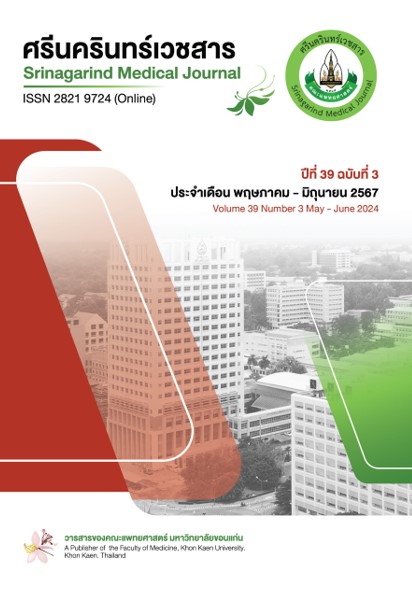Treatment Outcomes of Patients with Cervical Intraepithelial Neoplasia with Loop Electrosurgical Excision Procedure in Yasothon Hospital
Keywords:
treatment outcomes, LEEP, cervical cancerAbstract
Background and Objective: Yasothon Hospital utilized the loop electrical excision procedure (LEEP) to manage pre-cancerous lesions, typically performed by general obstetrician and gynecologist. Previous studies in Yasothon hospital there was no definite conclusion of the treatment outcomes of LEEP. This study aimed to evaluate the treatment outcomes, determine prevalence and identify factors associated with recurrence after LEEP.
Methods: We conducted a retrospective cohort study. The participants were all women undergoing LEEP in Yasothon hospital between January 2019 - June 2023. Data were collected from medical records.
Results: The mean age of participants was 45.0 year. Most cases were associated with HPV 16 (35.2%) and HPV 18 (16%), with cytology showing CIN 2/3 (66.4%). The histopathology results post LEEP indicated CIN 2/3 (57.6%) of case, with positive margin present in 46.4% and complications in 24.0%. The cytology after LEEP confirmed CIN 2/3 in 25.0% and cervical cancer in 5.7%. Prevalence of the persistence or recurrence was 36.4% (95%CI 26.4, 47.3). Factors significantly associated with recurrence of lesions after LEEP include positive margin and HPV DNA test results.
Conclusions: LEEP was good outcome and safety for women in this study. However, caution is advised regarding complications and recurrence screening, particularly in women with a positive margin and HPV DNA test result indicating HPV 16/18, who may require comprehensive follow-up after LEEP.
References
McCredie M, Sharples K, Paul C, Baranyai J, Medley G, Jones R SD. Natural history of cervical neoplasia and risk of invasive cancer in women with cervical intraepithelial neoplasia 3: a retrospective cohort study. Lancet Oncol 2008;9(5):425–34. doi: 10.1016/S1470-2045(08)70103-7.
World Health Organization(WHO). WHO guidelines for treatment of cervical intraepithelial neoplasia 2–3 and adenocarcinoma in situ. Switzerland; 2014.
Department of Health. Comprehensive control of cervical cancer. [Internet]. Ministry of Public Health. 2016 [cited Mar 1, 2024]. Available from: https://rh.anamai.moph.go.th/web-upload/7x027006c2abe84e89b5c85b44a692da94 /m_magazine /33336/1006/file_download/fa30505ac8be02ce3aa10a5edd41cb1b.pdf National Cancer Institute. Guidelines for screening, diagnosis and treatment of cervical cancer. Bangkok: Kosit Printing Co., Ltd.; 2018.
Obstetrics and Gynecology Department, Yasothon Hospital. Guidelines for treating cervical cancer. Yasothon; 2023.
Hillemanns P, Kimmig R, Dannecker C, Noorzai T, Thaler CJ, Hepp H. LEEP versus cold knife conization for treatment of cervical intraepithelial neoplasias. Comparative Study Zentralbl Gynakol 2000;122(1):35-42.
Santesso N, Mustafa RA, Wiercioch W, Kehar R, Gandhi S, Ahmad A, et al. Systematic reviews and meta-analyses of benefits and harms of cryotherapy, LEEP, and cold knife conization to treat cervical intraepithelial neoplasia. Int J Gynaecol Obstet 2016;132(3):266-71. doi:10.1016/j.ijgo.2015.07.026.
Khunnaronga J, Bunyasontikula N, Tangjitgamo S. Treatment outcomes of patients with cervical intraepithelial neoplasia or invasive carcinoma who underwent loop electrosurgical excision procedure. RSC Adv 2021;12(4):111–8. doi:10.14740/wjon1391
Kim BR, Kim MK, Kim YH. Effect of loop electrosurgical excision procedure on sexual dysfunction in korean women. J Korean Med Sci 2023;38(18):1–9. doi: 10.3346/jkms.2023.38.e144
D’Alessandro P, Arduino B, Borgo M, Saccone G, Venturella R, Cello A Di, et al. Loop electrosurgical excision procedure versus cryotherapy in the treatment of cervical intraepithelial neoplasia: A Systematic Review and Meta‑Analysis of Randomized Controlled Trials. Gynecol Minim Invasive Ther 2018;7(4): 145-51. doi: 10.4103/GMIT.GMIT_56_18
Santesso N, Mustafa R, Wiercioch W, Kehar R, Gandhi S, Chen Y,et al. Systematic reviews and meta-analyses of benefits and harms of cryotherapy, LEEP, and cold knife conization to treat cervical intraepithelial neoplasia Nancy. Int J Gynecol Obstet 2016;132(2016):266–71. doi:10.1016/j.ijgo.2015.07.026
Zhu M, He Y, Baak JPA, Zhou X, Qu Y, Sui L, et al. Factors that influence persistence or recurrence of high-grade squamous intraepithelial lesion with positive margins after the loop electrosurgical excision procedure: A retrospective study. BMC Cancer 2015;15(1):1–10. doi:10.1186/s12885-015-1748-1
Kanjanasirirut P, Pataradool K, Manusirivithaya S, Phaloprakarn C, Chavanisakun C. Prevalence and risk factors for positive surgical margin after loop electrosurgical excision procedure (LEEP) in patients with high grade squamous intraepithelial lesion. Thai J Obstet Gynaecol 2015;23(4):240–5.
Riibe MO, Sorbye SW, Simonsen GS, Sundsfjord A, Ekgren J MJ. Risk of cervical intraepithelial neoplasia grade 3 or higher (CIN3+) among women with HPV-test in 1990–1992, a 30-year follow-up study. Infect Agent Cancer 2021;16(1):1–9. doi: 10.1186/s13027-021-00386-z
Kilic H, Narin R, Adiguzel C, Narin MA, Sapmaz E. The effect of cervical conization on women’s sexual function and psychological health, A prospective observational study. J Sex Med 2021;19(2):257–62. doi:10.16919/bozoktip.823268
National Cancer Institute. Latest cancer statistics situation in Thailand – Thai Cancer News, TCN [Internet]. 2021 [cited May 10, 2023]. Available from: https://thaicancernews.nci.go.th/_v2/index.php/2019/12/31/kb2901li2479kj/
Downloads
Published
How to Cite
Issue
Section
License
Copyright (c) 2024 Srinagarind Medical Journal

This work is licensed under a Creative Commons Attribution-NonCommercial-NoDerivatives 4.0 International License.




